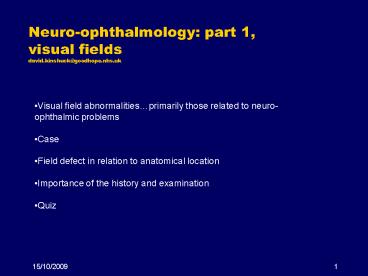Neuroophthalmology: part 1, visual fields david.kinshuckgoodhope.nhs.uk - PowerPoint PPT Presentation
Neuroophthalmology: part 1, visual fields david.kinshuckgoodhope.nhs.uk
Retinal vascular occlusion. Refractive error. 9/29/09. 7. Optic nerve. 9/29/09. 8. Optic nerve ... Superior retinal vein occlusion. Tunnel vision...young patient...RP ... – PowerPoint PPT presentation
Title: Neuroophthalmology: part 1, visual fields david.kinshuckgoodhope.nhs.uk
1
Neuro-ophthalmology part 1, visual
fieldsdavid.kinshuck_at_goodhope.nhs.uk
- Visual field abnormalitiesprimarily those
related to neuro-ophthalmic problems - Case
- Field defect in relation to anatomical location
- Importance of the history and examination
- Quiz
2
case
- A 43y woman complains of a mild headache (left
forehead). The headache has been present 2
months, and is not getting better. - As you listen she tells you the sight is dim in
left eye. - Examination confirms red colours in the left eye
are not as bright as when seen with the right
eye. - Further examination shows a pale optic disk and
afferent pupillary defect, and visual field
defect, but even without these findings a CT scan
is needed. CT scan details
3
case
4
Recallvisual pathway
5
Recalldisease of the eye itself causes various
visual symptoms
6
Recalldisease of the eye itself causes various
visual symptoms
7
Optic nerve
8
Optic nerve
9
Pituitary (chiasmal) area
10
Pituitary (chiasmal) area
right
left
11
Retrochisamal
12
Retrochisamal
13
Visual symptoms mini-quiz
old patient
Central vision reducedoptic nerve
Central vision reduced ARMD
Young patient
Superior retinal vein occlusion
Loss of colour visionoptic nerveunilateral
Tunnel visionyoung patientRP
This field both eyesCVA/SOL Temporal lobe
This field both eyesCVA/SOL
14
Questions
15
Summary
- The history can give you a BIG clue
- CT/MRI helpful but experts will locate lesion
without - Horizontal border to defects.eye
- Vertical..retro-chiasm
- Early diseasefew if any symptoms
- Small pituitary tumoursno field defect
(microadenomas) - Key symptoms can be very localising..eg loss of
colour vision in one eye, gradual increase in
headache over 2 months,
PowerShow.com is a leading presentation sharing website. It has millions of presentations already uploaded and available with 1,000s more being uploaded by its users every day. Whatever your area of interest, here you’ll be able to find and view presentations you’ll love and possibly download. And, best of all, it is completely free and easy to use.
You might even have a presentation you’d like to share with others. If so, just upload it to PowerShow.com. We’ll convert it to an HTML5 slideshow that includes all the media types you’ve already added: audio, video, music, pictures, animations and transition effects. Then you can share it with your target audience as well as PowerShow.com’s millions of monthly visitors. And, again, it’s all free.
About the Developers
PowerShow.com is brought to you by CrystalGraphics, the award-winning developer and market-leading publisher of rich-media enhancement products for presentations. Our product offerings include millions of PowerPoint templates, diagrams, animated 3D characters and more.































